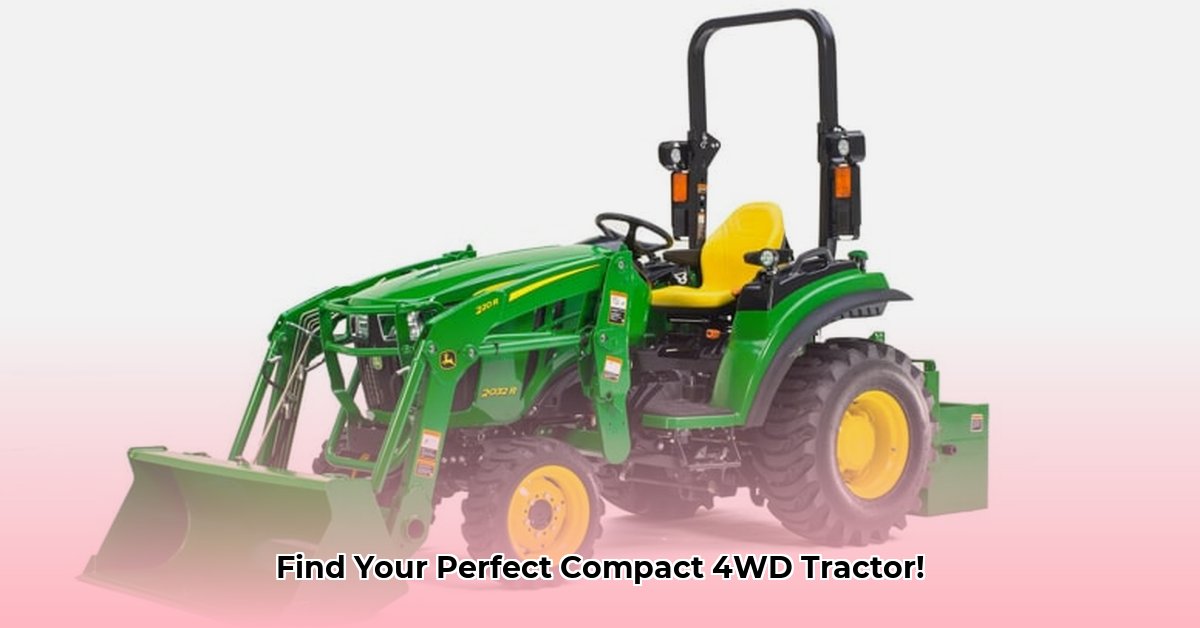
Choosing the right small 4-wheel drive tractor (also known as a compact tractor) can be a significant investment for both personal and professional use. This comprehensive guide simplifies the selection process, focusing on key features, comparing top models, and offering advice on maintenance and purchasing strategies. Whether you're a landscaper, small-scale farmer, or homeowner with acreage to manage, this guide will help you find the perfect machine for your needs and budget. Need financing? Check out these tractor loan options.
Key Features to Consider Before Buying a Compact Tractor
Selecting the optimal compact tractor requires careful consideration of several critical factors. Don't let the seemingly simple design fool you—there's a lot to consider before making your purchase.
Horsepower (HP): This indicates the engine's power. Higher horsepower allows tackling more demanding tasks like tilling heavy soil or pulling large implements (e.g., trailers, plows). Consider the toughest jobs you anticipate and choose accordingly. A higher horsepower generally translates to a larger price tag, but will be necessary if the job requires it.
Lift Capacity: This refers to the maximum weight your tractor’s three-point hitch (a system for attaching implements) can lift. This is crucial for using implements like backhoes, loaders, or tillers. Ensure the lift capacity meets your requirements for the heaviest attachments you'll use.
Essential Features: Features like power steering (simplifies maneuvering), a three-point hitch (enhances versatility), and a comfortable operator station (improves long-term usage comfort) greatly impact the user experience. Prioritize features that directly align with your needs and typical usage. Power steering is great for smaller spaces, better than standard steering which might become too strenuous and tiresome for users.
Budget: Compact tractors vary widely in price. Establish a realistic budget, including maintenance, fuel, and potential repairs, before comparing models. A budget should be established before narrowing down your options, this avoids the risk of making an unsuitable purchase due to financial constraints.
Fuel Efficiency: Fuel efficiency impacts long-term operational costs. While higher horsepower models are more powerful, they usually consume significantly more fuel. Choosing a more fuel-efficient model can lead to considerable savings over time, especially with frequent use. This can be significant in the long run, leading to cost savings.
Top Small 4WD Tractor Models Compared: A 2025 Overview
This section compares popular small 4-wheel drive tractor models available in 2025. Remember, specifications and pricing can change, so always verify details with the manufacturer or a local dealer.
| Model | Horsepower | Lift Capacity (lbs) | Key Features | Estimated Price Range (USD) | Pros | Cons |
|---|---|---|---|---|---|---|
| John Deere 1025R | 25 | 1,100 | Power steering, three-point hitch, high-end features | $15,000 - $20,000 | Excellent build quality, robust performance | Higher initial cost |
| Kubota BX23S | 23 | 1,000 | Compact size, user-friendly design, reliable | $13,000 - $18,000 | Compact and maneuverable, good value for money | Slightly lower lift capacity compared to others |
| Mahindra 1526 | 26 | 1,200 | Value-oriented, durable build, good for larger jobs | $12,000 - $17,000 | Affordable, strong performance for the price | May lack some high-end features |
| New Holland Boomer 25 | 25 | 1,050 | Smooth operation, known for reliability | $16,000 - $21,000 | Reliable operation, ease of use | Can be more expensive than some competitors |
Note: Prices are estimates and can vary based on dealer, optional features, and location.
Maintenance and Considerations Before Purchasing
Regular maintenance is crucial for extending the lifespan of your tractor and preventing costly repairs. This includes routine tasks like oil changes, filter replacements, and regular inspections. Prioritizing maintenance will reduce the likelihood of costly repairs and prolong the tractor's lifespan.
Before purchasing, take these steps:
Thorough Research: Read online reviews, compare prices from multiple dealers, and compare models side by side.
Test Drive: Test drive different models to experience their handling and features firsthand. This helps assess comfort and maneuverability before purchasing.
Account for Maintenance Costs: Factor in ongoing maintenance, fuel, and potential repair costs into your budget. Planning for these expenses prevents financial surprises.
Attachment Compatibility: Check compatibility of the tractor with the attachments you need given your expected uses for the tractor. This ensures your capabilities are supported.
Conclusion: Finding the Right Tractor for You
Choosing a small 4-wheel drive tractor requires careful consideration of various factors. Using this guide as a starting point, conduct thorough research, compare models, and prioritize features that best address your specific needs and budget. Remember to factor in the long-term costs associated with maintenance and repairs to ensure a sound investment.